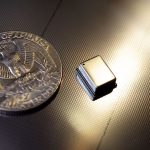GMV Aerospace and Defense has developed a system for a pan-European, public time distribution. At the recent AltPNT Demonstration Day at the European Commission’s Joint Research Center (JRC), Ricardo Píriz, from GMV AD’s GNSS Time and Frequency Group, explained how his company can provide Galileo System Time (GST) or Galileo UTC via existing networks.
“This would work as a general-purpose service, or it could be focused on critical infrastructure,” said Píriz, “and different networks can be used, giving different accuracy levels.”
GMV AD was selected under a European Commission (EC) call for tenders to demonstrate mature, alternative PNT technologies, in view of some of the inherent vulnerabilities of GNSS. The company already provides a time service called WANTime in its home city of Madrid, distributed over optical fiber using the White-Rabbit network protocol. The service is based on two parallel and independent time generation chains, each driven by a highly stable passive hydrogen maser atomic clock. The clocks can be synchronized to UTC by means of GNSS time-transfer to any national timing laboratory. At the JRC event, GMV demonstrated how a similar technology, dubbed WANTime4EU, can be adapted to function over different existing networks across different countries.
“Using a typical FTTH [fiber to the home] infrastructure, like the one we employed in Spain, we showed good general stability,” Píriz said, “considering the inexpensive nature of this network service.” Observed jitter was 1 µs (1-sigma) over one day, and a ‘bump’ was observed once a day at nighttime. “Jitter, outside the bump, was 150 ns, 1-sigma,” said Píriz, “which exceeded the EC requirement of 1 µs at 3- sigma.” There was an occasional loss of lock, and there was a large mean offset due to network asymmetry. “This is unavoidable in FTTH,” Píriz said, “so there is a link calibration required, and we can see occasional jumps in the link after several days, due to network reconfiguration.”
GMV also demonstrated time synchronization using dynamic synchronous transfer mode (DTM) technology by Nimbra, over a moderately priced, multi-protocol label switching (MPLS) network service. This system is currently operating over distances up to 300 km in Germany. Píriz reported, “We showed excellent results over the MPLS, with very good stability over many days.” Maximum error was 500 ns, again exceeding EC requirements for the demonstration. The mean offset was a very small 240 ns, requiring no link calibration, and jitter was 140 ns (1-sigma).
Hardware used in the demonstration included, on the server side, a Passive Hydrogen Maser, a frequency stepper, a provision for GNSS time transfer against UTC(k), a Nimbra box for DTM, and the network links. On the client side, required hardware included a Nimbra box, a WANtime GNSS receiver and a time interval counter.






